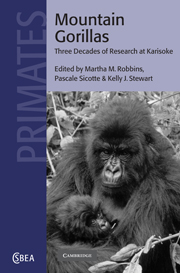Book contents
- Frontmatter
- Contents
- List of contributors
- Acknowledgements
- To Dian Fossey
- 1 Mountain gorillas of the Virungas: a short history
- Part I The social system of gorillas
- Part II Within-group social behavior
- Part III Feeding behavior
- Part IV Conservation and management of mountain gorillas
- 12 Assessment of reproduction and stress through hormone analysis in gorillas
- 13 Clinical medicine, preventive health care and research on mountain gorillas in the Virunga Volcanoes region
- 14 Conservation-oriented research in the Virunga region
- 15 Status of the Virunga mountain gorilla population
- Afterword: mountain gorillas at the turn of the century
- Index
14 - Conservation-oriented research in the Virunga region
Published online by Cambridge University Press: 16 March 2010
- Frontmatter
- Contents
- List of contributors
- Acknowledgements
- To Dian Fossey
- 1 Mountain gorillas of the Virungas: a short history
- Part I The social system of gorillas
- Part II Within-group social behavior
- Part III Feeding behavior
- Part IV Conservation and management of mountain gorillas
- 12 Assessment of reproduction and stress through hormone analysis in gorillas
- 13 Clinical medicine, preventive health care and research on mountain gorillas in the Virunga Volcanoes region
- 14 Conservation-oriented research in the Virunga region
- 15 Status of the Virunga mountain gorilla population
- Afterword: mountain gorillas at the turn of the century
- Index
Summary
Threats to gorillas in the Virungas during the 20th century
Gorilla (Gorilla gorilla) populations are threatened throughout their range, primarily by human activities. As human populations increase in Africa the available room for gorillas is decreasing and gorillas are coming into contact with humans much more than they used to. Each of the three subspecies (see chapter 1 for discussion about possible changes in taxonomy), G. g .gorilla(population of about 110 000), G. g. graueri(population of about 17 000), and G .g. beringei(population of about 600) are threatened by slightly different factors that result from increasing human populations, and all gorilla populations are considered under IUCN criteria as either vulnerable or endangered (Harcourt, 1996). The major threats to gorillas can be categorized as: (1) habitat loss, modification, or fragmentation; (2) hunting or poaching; (3) disease transmission from humans; and (4) war or political unrest. The mountain gorillas in the Virungas have been exposed to each of these threats over the period during which western scientists have known about them.Despite the international publicity about these animals and despite their potential to earn foreign currency for the countries where they are found, mountain gorillas still face several of these threats. This chapter reviews the threats gorillas have faced in the Virungas over time and summarizes some of the research that has aimed to address these threats and provide information to park managers to better conserve the gorillas. We focus primarily on Rwanda and the Parc National des Volcans because the Karisoke Research Center, where most researchers have been based, is in this country.
- Type
- Chapter
- Information
- Mountain GorillasThree Decades of Research at Karisoke, pp. 361 - 390Publisher: Cambridge University PressPrint publication year: 2001
- 7
- Cited by

